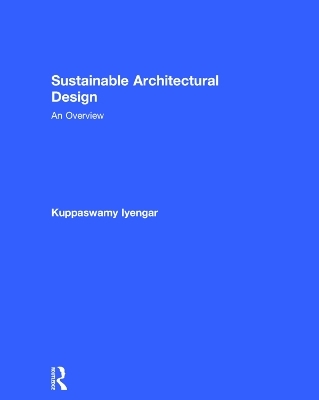
Sustainable Architectural Design
Routledge (Verlag)
978-0-415-70234-8 (ISBN)
Includes an overview of alternate assessment and evaluation systems such as BREEAM, CASBEE, GBTool, Green Globes alongside LEED, ECOTECT, energy 10, HEED and eQuest simulation programs. The guide reveals the importance of the building envelope—walls, superstructure, insulation, windows, floors, roofs, and building materials—on the environmental impact of a building, and has a section on site systems examining site selection, landscape design, thermal impact, and building placement.
Kuppaswamy Iyengar is an Associate Professor, Associate Director, and Regents Lecturer in the architecture program at the University of New Mexico. Professor Iyengar is a highly skilled teacher and technical consultant, combining his degrees in civil and structural engineering and architecture with over fifty years' practical experience. In addition to developing academic courses of study, he has designed and presented over 50 seminars in professional settings, bringing his expertise to students in academic, governmental, and commercial locations in India, Barbados, the USA, England, Canada, Australia, the Philippines, and Thailand.
Acknowledgements. Introduction. 1. Rationale For Sustainable Buildings 1.1. Rationale for Sustainable Buildings 1.2. Lessons From Nature 1.3. Principles And Philosophy 1.4. Critical Perspectives 2. Passive Sustainable Design Ideas/Tools 2.1. Principle Sustainable Building Design Ideas 2.2. Passive Heating – Energy From Sun 2.3. Passive Cooling - Sun Control, Orientation and Ventilation 2.4. Passive Cooling – Air and Water Systems 2.5. Ground Source and Other Heating & Cooling 2.6. Sustainable Technologies: Works in Progress 3. Site Issues 3.1. Selection and Analysis 3.2. Landscape Design 3.3. Thermal Impact of Urban Infrastructure 3.4. Placement of Buildings 3.5. Building Clusters 4. Building Envelope 4.1. Thermal Loads 4.2. Role of Insulation 4.3. Sustainable Materials/Construction 4.4. Walls and Superstructure 4.5. Windows 4.6. Floors and Roofs 5. Active Environmental Systems 5.1. Lighting Design 5.2. HVAC Design 5.3. Indoor Air Quality 5.4. Water and Waste Management 6. Evaluation Tools & Examples 6.1. Evaluation of Sustainable Buildings 6.2. Energy Sources and Sustainability Audits 6.3 Case Studies. Conclusion. List of Figures. List of Tables. List of Charts. Index
| Erscheint lt. Verlag | 9.7.2015 |
|---|---|
| Zusatzinfo | 23 Tables, black and white; 112 Line drawings, color; 120 Halftones, color |
| Verlagsort | London |
| Sprache | englisch |
| Maße | 219 x 276 mm |
| Gewicht | 1270 g |
| Themenwelt | Naturwissenschaften ► Biologie ► Ökologie / Naturschutz |
| Technik ► Architektur | |
| Technik ► Bauwesen | |
| Technik ► Elektrotechnik / Energietechnik | |
| ISBN-10 | 0-415-70234-8 / 0415702348 |
| ISBN-13 | 978-0-415-70234-8 / 9780415702348 |
| Zustand | Neuware |
| Haben Sie eine Frage zum Produkt? |
aus dem Bereich


